
Prepared on Notepad by Ian Smith, best on Netscape 800*600.
This page created 20th August 2002, updated 20th October.

Service and Decline
1978: change in the wind
The delivery of the last Fleetline, DM2646,
in August 1978 did not mark the end of the process of conversion to one man operation
- or even of the RTs. The Fleetlines were proving expensive to run,
with their increased costs of operation and maintenance
exceeding the gains made with opo compared to crew RT or RM operation.
Gearboxes were still a major problem,
despite an increase in life-expectancy from about six weeks to about fifteen months!
It was hoped that the new generation of buses, the Leyland Titan and the MCW Metrobus
would avoid these problems and provide the cost savings that London Buses desperately
needed under the current government policy. Titans began to arrive in December 1978.
1979: withdrawals commence
Routemasters were still to be overhauled,
and as with the Swifts the Fleetlines could not all be accommodated at Aldenham
without a major expansion.
So the "Christmas-tree" hulks were disposed of,
and a policy decided as to which Fleetlines should be over-hauled and which sold.
One or the other was needed, as by now the large batches bought in 1972
were reaching expiry of their seven year certicates of fitness.
It was decided that in general Park Royal DMSs should be overhauled, and MCW DMSs sold.
With the exception of DMS1332, which went to the experimental department,
a great block of MCWs went: DMS1248-DMS1374. A few went to Wombwell Diesels,
and a scatter were sold directly to other operators,
but the bulk went to the Purfleet marshes,
where Ensign Coach & Bus was to set up a considerable business in DMS refurbishments,
rebuilds, and sales. Between withdrawal and sale they cluttered up many garages and yards,
and LT rented space at the old AEC Southall works to store them,
as well as using the old Turnham Green garage.
The automatic fare collection (afc) equipment was finally abandoned during 1979:
passengers were directed to pay the driver by barriers.
Some buses were equipped to allow either driver-only or crew operation,
and the "flip-flap made its appearance:
a blue/yellow flip-over board on bus front and internal cab door that said "Pay Driver" or Pay Conductor".
Some of the withdrawn MCW buses had been fitted with flat-fare equipment for the Croydon C-routes,
and this was transferred onto the replacement Park Royal buses.
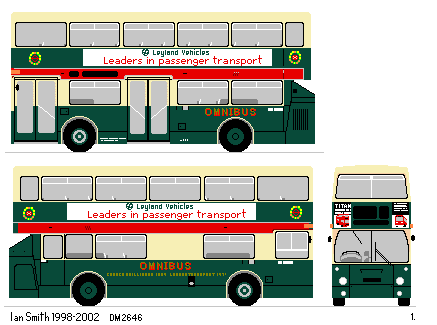
Shillibeer
DM2646, the last Fleetline,
was repainted in a simplified version of the Shillibeer Omnibus livery
to commemorate 150 years of public bus services in London.
The overall colour scheme was dark blue-green and primrose, with a red side-stripe.
"Omnibus" fleetnames were carried,
and two floral wreaths each side contained the Shillibeer and LT bullseye motifs.
This was the vehicle that Leyland had insisted on to advertise their expertise in
bus building, with front adverts for the Titan and the National,
and rather odd side adverts that seemed ashamed of the Leyland name. This was advertising?
Wearing Cricklewood route 16 blinds it appeared at the official celebration at London's Guildhall
on 2nd March 1979, with twelve RMs. Subsequently it was used at Muswell Hill on route 134, and at Brixton.
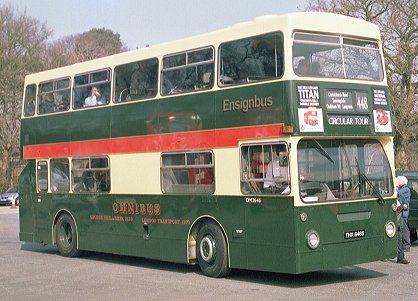
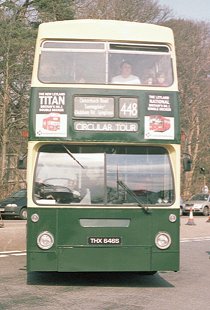
Ensignbus subsequently restored DM2646 into Shilibeer livery for its heritage operations. In April 2007 it provided circular tours from Chobham to Virginia Water during the Cobham Museum Open Day.
Routemasters, Metrobuses and Titans replace DMSs
In March 1979 Fulwell replaced the DMSs on route 270 with new Metrobuses.
April and May saw routes 281 and 90B similarly converted.
Routemasters took over from opo DMSs on the 106 in March.
So began a period of considerable flux in the allocations of Fleetlines,
as the new buses filtered into service and the Fleetlines moved around into new nooks and crannies,
or fell by the wayside, sometimes after being at just one location all their working lives.
Titan production was slow, and their introduction at Hornchurch was protracted,
and not without difficulties requiring the re-import of Fleetlines.
Leyland Nationals replace DMSs too
The autumn saw another development at Bromley, where first the 61 and then the 126/138 were
converted to Leyland National operation in September/October, removing all the DMSs from Bromley.
Holloway replaced DMSs with Nationals on route 239 in December.
Elsewhere, Upton Park's route 101 reverted to Routemasters, and Turnham Green's N97, 91 and 267 changed to Metrobuses.
North Street began converting to Titans.
Even so, so many Fleetlines were taken out of service as their seven year certificates expired
that routes 224, 84 and 42 had to be converted to SMS operation.
1980: Recertifications, withdrawals, trainers, and the D sub-class
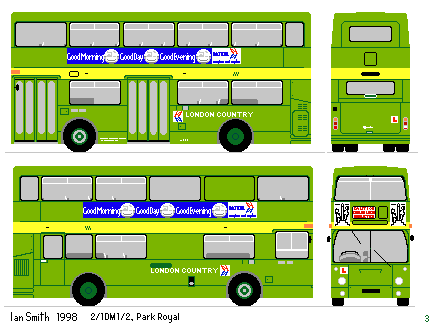 The start of 1980 saw a few DMSs recertificated
- too many were expiring for new arrivals to replace.
Fifty-four were converted by London Transport as permanent driver trainers.
These were fitted with an extra seat, an extra handbrake,
more mirrors, and indicator lamps - all for the instructor.
The normal complement of seats, and the staircase, were retained,
allowing their reclamation later if required.
At this stage they retained normal livery and DMS fleetnumbers.
The start of 1980 saw a few DMSs recertificated
- too many were expiring for new arrivals to replace.
Fifty-four were converted by London Transport as permanent driver trainers.
These were fitted with an extra seat, an extra handbrake,
more mirrors, and indicator lamps - all for the instructor.
The normal complement of seats, and the staircase, were retained,
allowing their reclamation later if required.
At this stage they retained normal livery and DMS fleetnumbers.
Eight DMSs were also bought by London Country for the same purpose,
and repainted into NBC green with a yellow band.
More DMs were made suitable for either opo or crew use,
with fittings for a ticket machine and a cash tray on the driver's door.
These were now denoted by a D class-code, although many examples continued to wear DM.
During 1980 the programme of introductions of Metrobuses in the west and Titans in the east
progressively squeezed the Fleetlines to the south. Daimlerland was having a revival.
1981
The introduction of Annual Freedom from Defect certification
meant an end to the automatic withdrawals upon expiry of the seven-year Certicate of Fitness.
The implementation of the new policy gave an automatic extension to the certicates
until December for all buses with current certificates on 1st April 1981,
which gave LT a breathing space with the DMSs. They had to decide what to keep by December though!
The year saw the Park Royal Fleetline fall from favour. Overhauls on them ceased,
and MCWs in the 18** series started to be overhauled instead.
Leyland engines -found in the new buses as well - were favoured over Gardners too.
DMs were also distinctly out of favour, and DMs and Ds went for sale rather than overhaul.
Titans pushed Fleetlines out of Walthamstow during the year,
and Metrobuses eased in to Potters Bar and Enfield later in the year.
1982: The end of Fares Fair: wholesale withdrawal
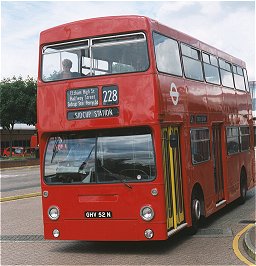 The major event in 1982 was the implementation of service reductions on 4th September,
following the Law Lords ruling in favour of London Borough of Bromley against the Greater London Council.
A previous (Conservative) GLC had introduced a 25p flat-fare,
which was wildly unpopular as it raised short-distance fares (10p) rather significantly.
The population showed what it thought of it by electing a Labour-controlled GLC to replace it, in May 1981.
From October 1981 they introduced Fares Fair,
a low-fares policy subsidised by a precept on rates throughout the GLC area.
Bromley, which had no tube services, felt agrieved on behalf of its Conservative-voting people,
and took them to court. Bromley lost.
They went to appeal, and the Lords ruled that Fares Fair was illegal.
The upshot was that in September 1982 fares were roughly doubled again throughout London,
and services had to be slashed drastically to cut costs. Car usage soared. Congestion increased.
Many buses were withdrawn.
Hundreds of Fleetlines (and Routemasters) went into store - mostly at the Ensign Bus & Coach Ltd premises at Purfleet.,
awaiting sale to Ensign.
The major event in 1982 was the implementation of service reductions on 4th September,
following the Law Lords ruling in favour of London Borough of Bromley against the Greater London Council.
A previous (Conservative) GLC had introduced a 25p flat-fare,
which was wildly unpopular as it raised short-distance fares (10p) rather significantly.
The population showed what it thought of it by electing a Labour-controlled GLC to replace it, in May 1981.
From October 1981 they introduced Fares Fair,
a low-fares policy subsidised by a precept on rates throughout the GLC area.
Bromley, which had no tube services, felt agrieved on behalf of its Conservative-voting people,
and took them to court. Bromley lost.
They went to appeal, and the Lords ruled that Fares Fair was illegal.
The upshot was that in September 1982 fares were roughly doubled again throughout London,
and services had to be slashed drastically to cut costs. Car usage soared. Congestion increased.
Many buses were withdrawn.
Hundreds of Fleetlines (and Routemasters) went into store - mostly at the Ensign Bus & Coach Ltd premises at Purfleet.,
awaiting sale to Ensign.
DM1052 was a 1982 casualty, being withdrawn from Stockwell in January.
It lived to run another day, however, and fully restored to its earlier glory it is seen
at Eltham Well Hall Station in June 2002, on a Running Day.
Even the B20s were not immune, with the allocations from Muswell Hill and Westbourne Park
going into store at Finchley, or service at Sutton, until further work was found for them.
1983: LT Jubilee
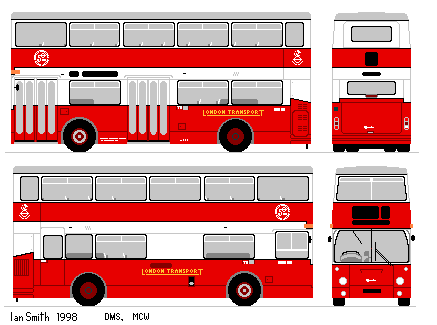 Four Fleetlines were involved in the 1983 celebrations of London Transport's Jubilee.
Oddly, these did not include DMS1983 (CF). But DS1933 at Thornton Heath was repainted into
1930's style livery, with red and white body with black lining and silver roof.
DS1933 also wore gold London Transport fleetnames (underlined), the London Transport Jubilee roundel,
and a white Wandle District logo. The "flip-flap" from the front was replaced by slipboards,
and a Daimler scroll-badges were added to the front and rear.
The front number plate went back on the bottom panel. It looked excellent.
What a pity the rest of the fleet did not receive the same treatment!
Four Fleetlines were involved in the 1983 celebrations of London Transport's Jubilee.
Oddly, these did not include DMS1983 (CF). But DS1933 at Thornton Heath was repainted into
1930's style livery, with red and white body with black lining and silver roof.
DS1933 also wore gold London Transport fleetnames (underlined), the London Transport Jubilee roundel,
and a white Wandle District logo. The "flip-flap" from the front was replaced by slipboards,
and a Daimler scroll-badges were added to the front and rear.
The front number plate went back on the bottom panel. It looked excellent.
What a pity the rest of the fleet did not receive the same treatment!
DMS1682, now owned by Ensign, was given a similar treatment and placed on the Round London Sightseeing Tour.
Renumbered DF1682, it had the 1933 livery and London Transport fleetnames,
but sported the Round London Sightseeing Tour posters on sides and front,
plus white bullseyes.
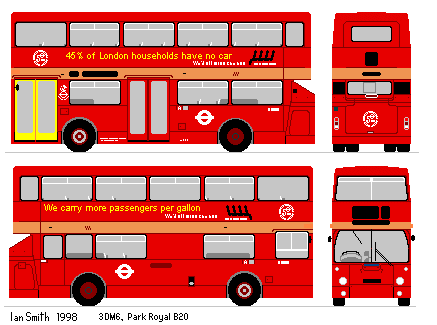
D2593 was also repainted by Wandle District, but less flambuoyantly:
the plain red was relieved by a gold cantrail band,
and the bus carried side adverts from the Bus and Coach Council
extolling the virtues of bus travel. It also carried the LT Jubilee logos between the decks,
LT bullseyes on the lower sides, and Wandle District logos.
Drawings of DS1933 and D2593 (above and left) were modified from my originals by Paul Watson.
DMS2205 was experimentally fitted with a Maxwell gearbox during 1983,
which ensured that it lasted in service longer than any of the other "standards".
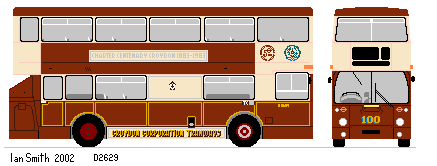
As well as London Transport's Jubilee 1983 saw the Centenary of Croydon's Borough Charter.
D2629 was repainted into a version of Croydon Corporation Tramways livery of chocolate and cream.
with panel lining out in gold and grey.
It bore the LT Jubilee logo, plus a Croydon Charter Centenary logo, both on the tween-decks.
Fleetname was Croydon Corporation Tramways.
A blue/gold 100 was on the front panel, above a Leyland badge and the number-plate.
A standard flip-flap was carried, plus small gold bullseyes next to the sidelights.
1984: Exit standards, enter London Regional Transport
The start of 1984 saw the last standard (ie not B20) Fleetlines withdrawn from normal service.
There was still a group of trainers, plus a number that appeared on special duties, including DS1933.
Catford acquired two open-toppers - DM948 and DM1102 - for the new Thames Barrier Serice from May 1984.
They were named, "MV Royal Eagle" and "MV Royal Daffodil" in February 1985, after the old Margate steamers.
With the standards out of ordinary service the next step was to concentrate the B20s into Wandle District,
a process that continued through the year and just into 1985.
This process produced a glut of opo B20 Fleetlines in Wandle,
and DMSs were used extensively on crew routes from summer 1984.
The new London Regional Transport decided to keep the B20s going until the late 1980s,
so restarted overhauls. Of 189 to be overhauled Aldenham only completed 20
before deciding that they could not be done economically to Aldenham standards.
The others went to outside contractors, or were overhauled by garages. The speed of overhaul
convinced observers that perhaps the job was not done as thoroughly,
and some buses subsequently went rather soon into Aldenham for protracted attention.
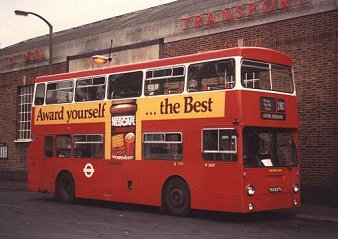
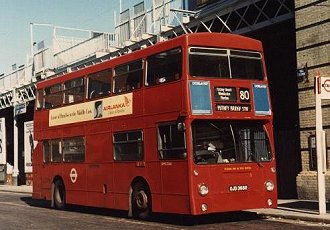
Sutton became all-Fleetline from September 1982.
D2537 arrived then for the crew 93, and is seen two years later at Sutton.
DMS2368 is seen at Putney Bridge Station, also in September 1984.
Both photos by Paul Watson. A whole gallery of photos from this period at Sutton can be seen
on Paul Watson's pages
Part5: Tenders and low-cost units

 Bus Stop Bus Stop
 Part 1. Part 1.
 Part 3. Part 3.
 Part 4. Part 4.
 Part 5. Part 5.
 bus histories. bus histories.
 photos. photos.
|

